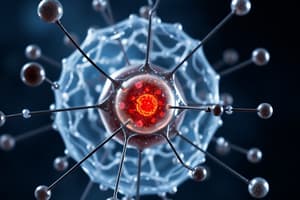Podcast
Questions and Answers
According to Hund's Rule, how do electrons fill energy levels?
According to Hund's Rule, how do electrons fill energy levels?
- They skip some energy levels and fill others randomly.
- They fill the lowest energy levels first. (correct)
- They fill energy levels randomly.
- They fill the highest energy levels first.
What determines the atomic number of an element?
What determines the atomic number of an element?
- Number of electrons
- Number of orbitals
- Number of protons (correct)
- Number of neutrons
What is the role of neutrons in an atom?
What is the role of neutrons in an atom?
- Help stabilize the nucleus (correct)
- Determine the atomic number
- Provide a negative charge
- Help fill electron shells
Which particles in an atom have opposite charges?
Which particles in an atom have opposite charges?
What is the function of an atom's electron configuration?
What is the function of an atom's electron configuration?
What property of an element does the atomic number determine?
What property of an element does the atomic number determine?
Which part of an atom has a negligible mass compared to the nucleus?
Which part of an atom has a negligible mass compared to the nucleus?
What differentiates isotopes of an element from each other?
What differentiates isotopes of an element from each other?
What is the measure of an atom's mass relative to the carbon-12 isotope?
What is the measure of an atom's mass relative to the carbon-12 isotope?
How does understanding atomic structure aid in explaining the behavior of elements?
How does understanding atomic structure aid in explaining the behavior of elements?
Flashcards are hidden until you start studying
Study Notes
Unraveling the Building Blocks: Understanding Atomic Structure
Atoms, the fundamental units of matter, are akin to miniature solar systems with their own unique arrangements and properties. To grasp the essence of our physical world, it's essential to dissect and decipher the structure of an atom.
The Atomic Nucleus
At the center of every atom lies a dense, positively charged core called the nucleus. This nucleus is made up of protons and neutrons. Protons are positively charged particles with a mass approximately 1836 times greater than that of an electron, whereas neutrons are neutral, having no charge. The number of protons in the nucleus determines the atomic number of an element, which in turn dictates the element's chemical properties.
Electrons in Orbit
Surrounding the nucleus, like planets orbiting the sun, are electrons. Electrons move in energy levels known as shells or orbitals. Each shell can accommodate a certain number of electrons, and these shells are filled from the lowest energy level upwards according to Hund's Rule, which states that electrons will fill the lowest energy levels first before moving to higher levels.
Electron Configuration
An atom's electron configuration is a description of the arrangement of its electrons in shells and orbitals. An electron configuration helps chemists understand the element's properties, reactivity, and periodic trends.
Atomic Number
The atomic number (Z) is the number of protons in an atom's nucleus and corresponds to the element's position in the periodic table. The atomic number determines an element's chemical properties.
Atomic Mass
The atomic mass of an element is a measure of an atom's mass relative to the carbon-12 isotope, which has been assigned a mass of 12 atomic mass units (amu). Atomic mass includes the mass of protons, neutrons, and electrons, but the mass of electrons is negligible relative to the nucleus.
Isotopes
Isotopes are atoms of the same element with different numbers of neutrons. They have the same atomic number but vary in mass number (A). For example, carbon has two naturally occurring isotopes: carbon-12 (12 protons and 6 neutrons) and carbon-13 (12 protons and 7 neutrons). Isotopes have different chemical and physical properties due to slight differences in mass.
Summary
The structure of an atom, with its nucleus comprising protons and neutrons, and its electron cloud orbiting the nucleus, forms the foundation of modern chemistry and physics. Understanding atomic structure aids in explaining the behavior of elements and compounds, and their interactions with one another. With such knowledge, we can comprehend the world around us and even manipulate matter at the atomic scale, opening the door to advanced technologies and scientific discoveries.
Studying That Suits You
Use AI to generate personalized quizzes and flashcards to suit your learning preferences.




